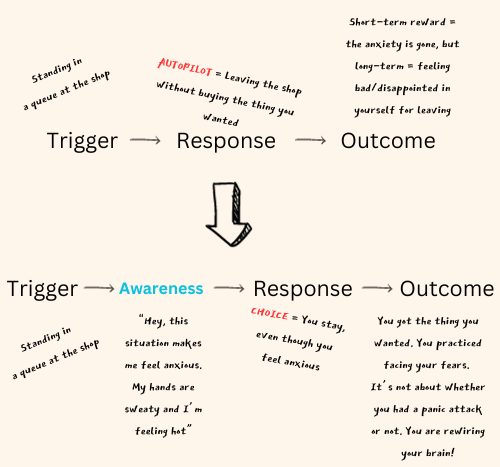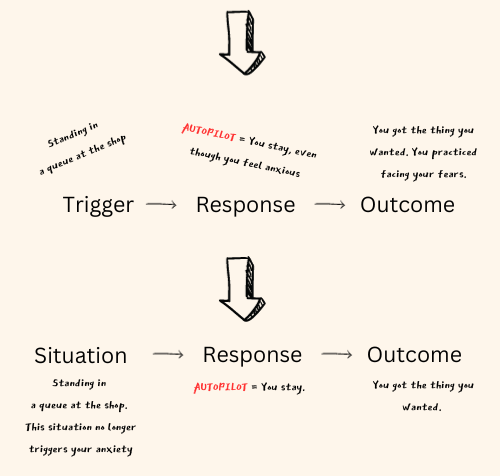
Have you been drinking enough so far today? No? Maybe you want to fill up your bottle or glass first…
Okay, now let’s get started with today’s post about habits.
What are habits?
A habit is a routine of behaviour that is repeated regularly and that occurs without thinking about it. Brushing our teeth, getting dressed, the way we dry ourselves after taking a shower, checking email, doing laundry, or praying. A habit is a response to a certain trigger. A trigger can be internal, for example, a thought, or external, like the smell of a pizza.
Habits are hard to break because they occur unconsciously. That is good news for our good habits, but not for the habits that we would like to change.
Take a look below at the stages of a habit. A habit is a response. In this case, you start with the habit of leaving the shop whenever you feel anxious. By bringing in awareness, you can change your response – or the habit – and subsequently, change the outcome.


Do you see what happened? Instead of reacting on autopilot, you now have a choice to do – or think – something differently.
However, that is easier said than done. We often get anxious for no obvious reason at all. What is important to remember, is that the brain associates negative thoughts or feelings with certain places, certain people, or certain situations. When you experience anxiety or panic attacks, your brain is literally programmed in a way that is not serving you anymore. I’m saying anymore, because evolutionary speaking, fear is a good thing, but when it develops into anxiety, it’s not helpful for us. (learn more)
Thinking negatively instead of positively is hardwired in the brain. It’s called the negativity bias. We immediately interpret a situation negatively (initially), in case it might be dangerous and we need to fight or flight. This is the easy road, the ‘highway’. It’s fast. Why would the brain choose the hard way – a bumpy, muddy road?
The Default Mode Network
Incoming: a bit of neuroscience. Researchers noticed that activity in specific brain regions was increasing while participants were supposedly at rest during tasks in a fMRI (functional magnetic resonance imaging) study. This increase in certain brain areas while daydreaming or mind-wandering – not performing an active task – was then called the Default Mode Network. (study) This network is active whenever your mind turns to thinking about self-related past and future scenarios. So, it’s most active when we’re inwardly focused.
For most of us, when we start mind-wandering or daydreaming, we start worrying or stressing about things we still have to do. Often it’s about situations that have not happened yet, but just thinking about it is enough to make you feel anxious or stressed. This mind-wandering usually happens on autopilot and often involves negative thoughts, especially for people who experience anxiety and panic attacks. Research has shown dysfunction of the Default Mode Network in several anxiety disorders. (study)
How do we change our habits, and consequently decrease anxiety?
As we’ve seen in the habit stages-process above, we can stop the ruminating and worrying if we consciously bring in awareness. If the habit (the automatic response, such as a thought or an action) is to start worrying whenever you look at your to-do list, then the solution to breaking that habit is first and foremost by noticing that you’re worrying in the first place!
Noticing your thoughts… Bringing awareness to your mind. Shine a light on your thoughts. Stop the autopilot. Observe. There are many different ways to describe a thing called mindfulness. So, mindfulness does not (necessarily) mean meditating. It literally means to be aware or to pay attention to the present moment.
When you are mindful, you will be presented with a choice. What kind of choice? A choice to change your thoughts. You can’t always change your initial reaction or thought to some trigger, whether that is entering a specific place, seeing a person, hearing the news, feeling an emotion, or having a thought. But once you are mindful of this first reaction, you can change what happens next.
How to lower anxiety by changing your habits
A misconception many people have is that you have to be meditating to be mindful. You can change habits by bringing awareness into the stages that every habit consists of. And being mindful is like a skill or a muscle. You need practice in order for it to get stronger. And it has nothing to do with willpower. You cannot bench press 100kg purely on willpower.
If you have been continuously anxious for months or even years, it makes sense that it can take weeks or months to learn how to actually relax and not worry all the time.
Thinking of anxiety as a habit might be a new way of looking at it for you. This perspective might help you to realize that you can break free from your anxiety as long as you understand how a habit works, and how you can change one. All it takes is time, practice, and attention.
“Mindfulness is a skill, not a quick fix. You need to learn how to relax. For many of us, it’s not something that we are able to do naturally. The more you do it, the easier it will get.”
Do you experience anxiety or panic attacks, and would you like to start changing the habits that are not helpful to you? The Program offers bite size information and practical exercises to help you break free from anxiety and panic attacks.
If you want to learn more about the relationship between habits and anxiety, I can recommend this podcast episode from The Proof.